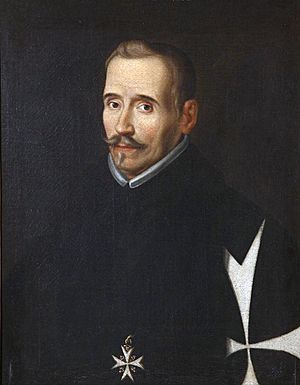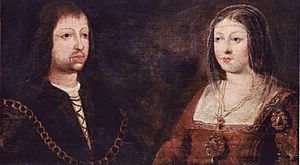Fuenteovejuna facts for kids
Fuenteovejuna (say it: Fwen-tay-oh-vay-HOO-nah) is a very famous play written by a Spanish writer named Lope de Vega. It was first printed in 1619, but people think Lope de Vega wrote it between 1612 and 1614.
The play tells a story based on something that really happened in a village called Fuenteovejuna in Castile, Spain, back in 1476. A military commander, Fernán Gómez de Guzmán, was in charge of the village. He treated the villagers very badly. Because of this, the people of the village worked together and killed him.
When a judge sent by King Ferdinand II of Aragon came to investigate, he tried to find out who was responsible. Even when they were in pain, the villagers all said the same thing: "Fuenteovejuna did it." This meant the whole village acted together.
Contents
Spain's Golden Age and a Royal Wedding
Many things changed quickly in Spain between 1476, when the real event happened, and 1614, when Lope de Vega wrote the play. During this time, Spain became a very powerful country. It was united under a royal family called the Habsburgs. Spain also discovered new lands, which made it even stronger.
When Lope de Vega wrote Fuenteovejuna, Spain was in its "Golden Century". This was a time when art, literature, and learning grew a lot.
In 1469, seven years before the events in Fuenteovejuna, Princess Isabella I of Castile married Prince Ferdinand II of Aragon. This marriage brought together the two biggest kingdoms in Spain: Castile and Aragon. This union helped the Christians finish taking back Spain from the Muslim Moors.
When Isabella became queen in 1474, another king, Alfonso V of Portugal, tried to take her throne. But Isabella and Ferdinand's forces won a big battle in 1476.
The Commander and the Village
In the same year, 1476, a city called Ciudad Real was attacked. Knights from the Order of Calatrava, led by a young master named Rodrigo Téllez Girón, supported King Alfonso. Ciudad Real was important because it was close to the border of Castile.
It was during this time that Commander Gómez de Guzmán was killed by the people of Fuenteovejuna. He had treated them very poorly. After the investigation, no single person was found guilty. So, King Ferdinand pardoned, or forgave, all the villagers of Fuenteovejuna.
What Happens in the Play
The play starts in a town called Almagro. Commander Fernán Gómez de Guzmán tells his leader, Rodrigo Téllez Girón, to capture Ciudad Real for King Alfonso. Girón agrees.
Then, we meet the people of Fuenteovejuna. They are talking about love and life. The Commander comes to the village and tries to take two women, Laurencia and Pascuala, to his castle. But they are strong and manage to get away.
Meanwhile, King Ferdinand and Queen Isabella talk about Ciudad Real being captured. They promise to take it back.
Later, two young people in love, Laurencia and Frondoso, meet in the forest. The Commander shows up and tries to force Laurencia to go with him. Frondoso hides and watches. When the Commander puts down his crossbow, Frondoso grabs it. Laurencia escapes, and Frondoso points the crossbow at the Commander. He leaves with the crossbow, and the Commander is very angry.
Trouble in the Village
In the second part of the play, the villagers are talking when the Commander arrives. He demands that Esteban, Laurencia's father, let him have Laurencia. Esteban refuses, and the Commander sees this as an insult.
A soldier then tells the Commander that Ferdinand and Isabella's army has surrounded Ciudad Real. The Commander leaves. Laurencia, Pascuala, and another villager named Mengo try to run away. They meet another girl, Jacinta, who is also being chased by the Commander's men.
Soon after, Esteban agrees to let Laurencia and Frondoso get married. The wedding begins, but the Commander interrupts it. He arrests Frondoso for threatening him with the crossbow. He also arrests Esteban and Laurencia when they protest.
The Villagers Fight Back
The third part of the play begins with the men of the village meeting to decide what to do. Laurencia enters, looking very hurt and upset. She had been mistreated by the Commander's men but managed to escape. She scolds the men for not trying to save her. Her words inspire the men to fight back and kill the Commander.
While the Commander's men are getting ready to hang Frondoso, the villagers rush in. They kill the Commander and one of his servants. Another servant, Flores, escapes and tells Ferdinand and Isabella what happened. The rulers are shocked and send a judge to Fuenteovejuna to investigate.
The villagers are celebrating with the Commander's head. They are told the judge is coming. To protect themselves, they all agree to say "Fuenteovejuna did it." The judge tries to torture men, women, and even young boys to get a different answer, but everyone keeps saying the same thing.
The judge gives up. Ferdinand and Isabella pardon the Grand Master. When the villagers come and tell their story, the King and Queen also pardon them.
Important Ideas in the Play
Fuenteovejuna explores several important ideas:
- Fairness and Power: There is a big difference between the powerful people, like the Commander, and the ordinary villagers. The Commander uses his power and wealth to treat the town badly. The play shows that only when the villagers work together can they fight back.
- Women's Strength: This is a surprising theme for the time the play was written. The Commander treats the women of the village very poorly. It is Laurencia who bravely encourages the town to stand up against the Commander. Women also play a key role in fighting back.
- Justice and Change: Spain was changing a lot during this time. The killing of the Commander is not just a murder; it's a rebellion against unfair rule. Even though Ferdinand and Isabella pardon the villagers, they are not happy about it. The play makes us think about what is right and wrong when people are treated so badly.
Other Versions of the Play
- A ballet called Laurencia was made based on Fuenteovejuna.
- The play has been made into movies several times in Spanish and other languages.
- A musical version was created in 1972.
- The play has been performed in theaters around the world, including at London's Royal National Theatre in 1989 and the Stratford Shakespeare Festival in 2008.
- A modern play called The Village, set in India, is also based on Fuenteovejuna.
See also
 In Spanish: Fuenteovejuna para niños
In Spanish: Fuenteovejuna para niños




